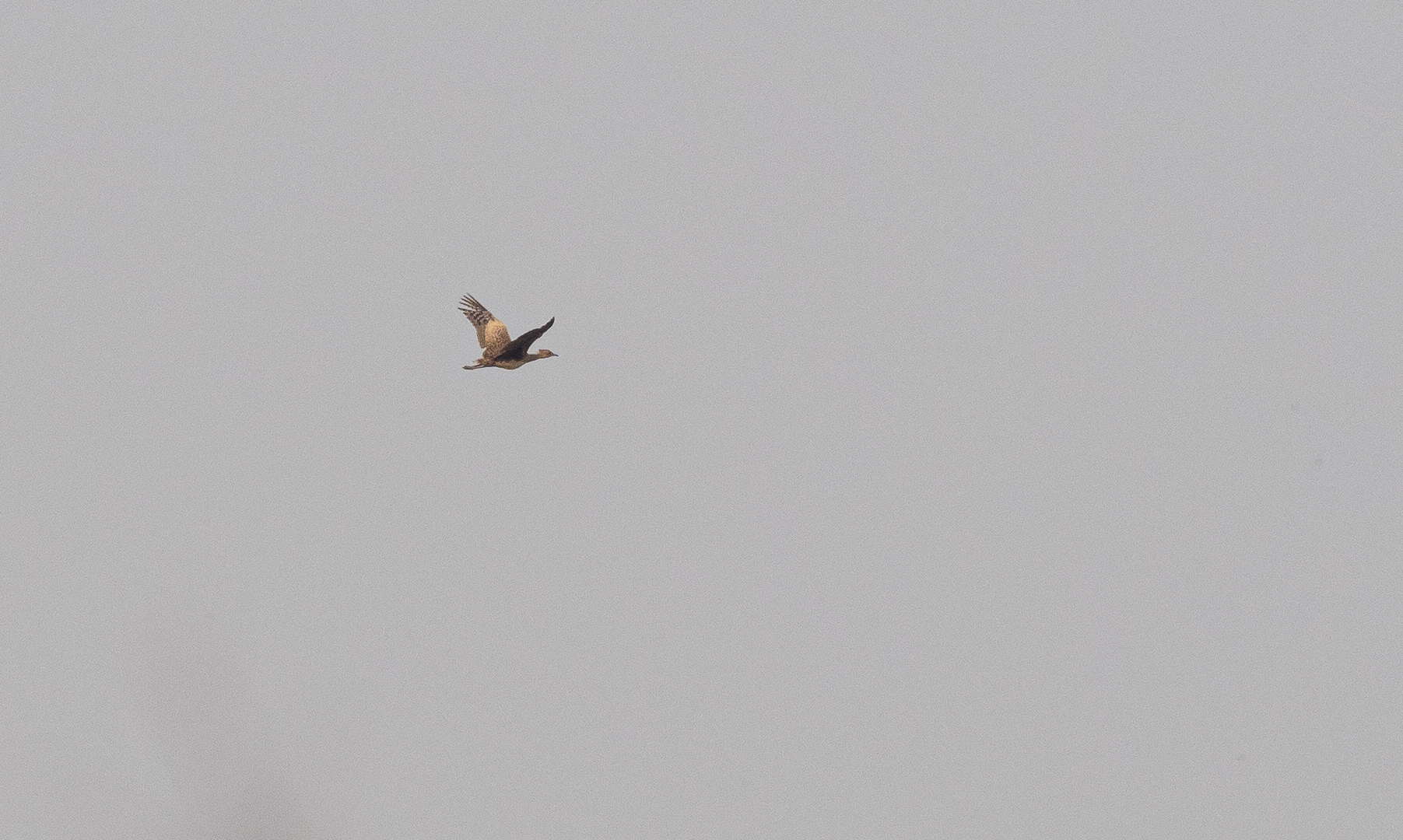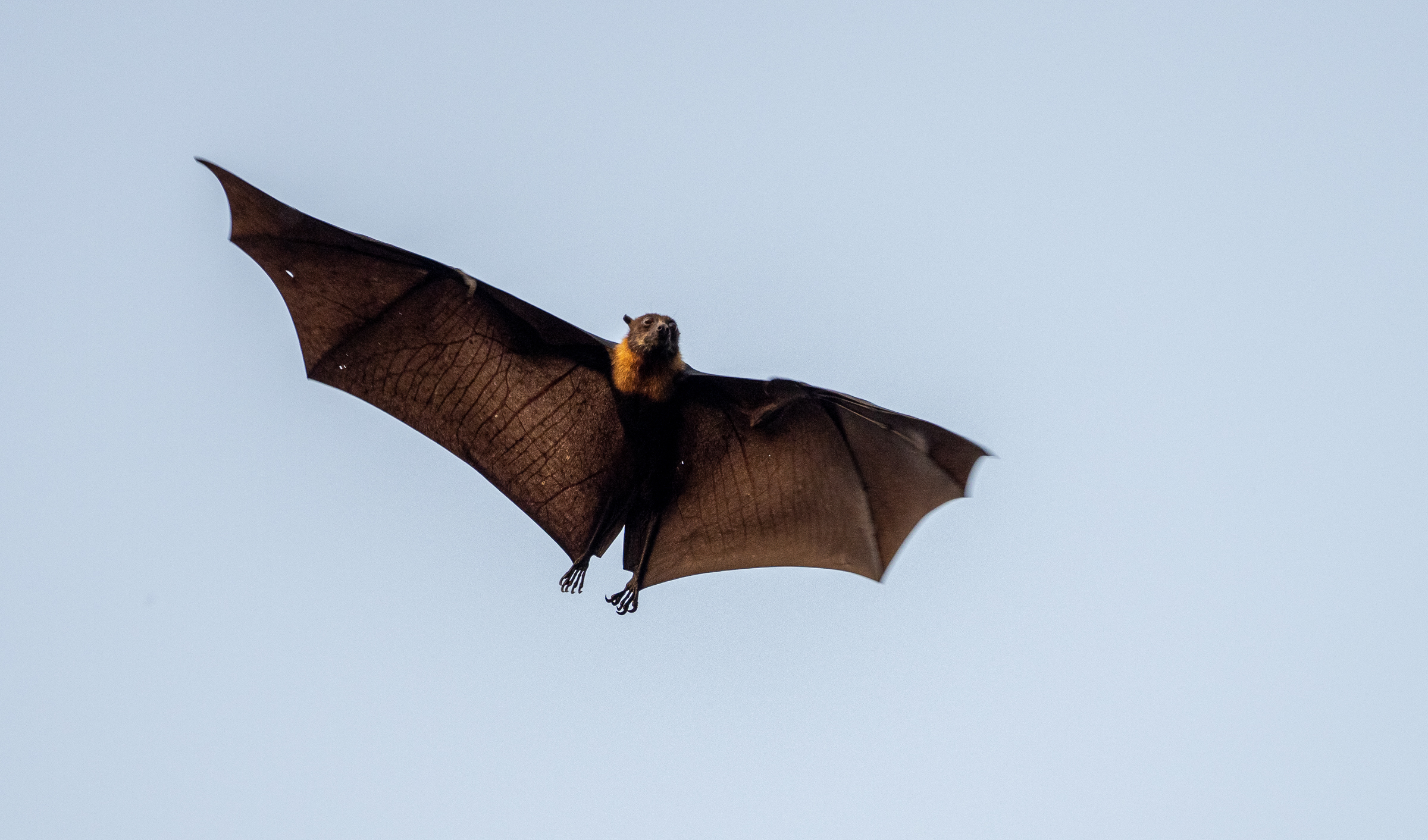 |
| Bengal Florican, one of the most endangered birds in the world |
Following my epic weekend trip to Ang Trapeang Thmor and Changkran Roy the weekend of March 11, I had to return to Phnom Penh for some final work meetings. I barely had time for birding (and was kind of exhausted anyway, but I was able to make a late afternoon stop by the Wat Phnom temple (Phnom Penh's namesake!) downtown to look for the Lyle's Flying Fox colony that has improbably taken up residence at a government office next door. Sure enough there were a couple hundred flying foxes roosting in the trees, and becoming increasingly active as the sun went down. I love bats so it was definitely a treat to see them flying around like this in the daytime, even if photographing them in the dimming light was a challenge.
 |
| Lyle's Flying Fox |
In addition to the flying foxes, it turned out that Wat Phnom is also where the feral hornbills of Phnom Penh go to roost in the evening. I first saw the Wreathed Hornbills I'd seen before, but soon after saw a group of enormous Great Hornbills flying in. I got to spend a good half hour watching these enormous hornbills flap around right above the traffic, perching on lampposts and on the eaves of government offices before it got dark. A no less surreal experience than my first time seeing them, and nice to get a surprise lifer, even it's from a feral population. I asked Nara about the Phnom Penh hornbills later, and apparently no-one really knows where they came from; they just kind of appeared downtown a few years ago. Certainly one of the strangest, and coolest urban birds I've ever seen.
 |
| Wreathed Hornbill |
 |
| Great Hornbill! |
My work finished officially on Tuesday the 15th, after which I had 5 days to spend birding in Cambodia before heading back to the Philippines. The plan was to use this time to look for some of the best-known Cambodian specialties. While Cambodia doesn't have many endemics like the Philippines, or vast protected areas like Thailand, it is nonetheless home to an impressive set of extremely rare and endangered species, some of which are difficult or near impossible to see anywhere else in the world. These include Giant Ibis, White-shouldered Ibis, Bengal Florican, Greater Adjutant, Red-headed Vulture, White-rumped Vulture, and Slender-billed Vulture. The vultures are usually only found at the so-called "vulture restaurants", where local villages set aside animal carcasses for them to feed on, free of the diclofenac that is decimating vulture populations throughout Europe, Asia, and Africa. Unfortunately those restaurants are eye-poppingly expensive for a solo birder on a budget, so I decided to skip that for this trip and focus on the ibises, the florican, and the storks. Once again I went with the Cambodia Bird Guide Association (highly recommended!), with Nara as my guide (also highly recommended!).
The plan was to start by looking for Bengal Floricans on Wednesday morning, March 16. Unfortunately, the only accessible place where floricans can be seen in the country, the creatively-named Bengal Florican Preserve, lies much closer to Siem Reap than it does to Phnom Penh, meaning I had to find a way to get there by Wednesday early morning. Thus, I reluctantly checked out early from my nice, work-sponsored hotel and boarded a night bus towards Siem Reap at 11 in the evening. The nice thing was that it was a "hotel bus", which means that passengers get to sleep in little single beds on the bus. The downside was that apparently since I was traveling on my own I got to share my tiny little bed compartment with a total stranger, meaning I didn't have enough room to properly stretch out or get into any other moderately comfortable position.
After a long, uncomfortable ride with very little sleep, I staggered off the bus at 3AM in the little town of Kampong Kdei, about an hour outside of Siem Reap. From there I just found an empty chair in the closed-down market and waited in the dark for a couple hours until Nara and Johnny from CBGA came to pick me up at 5AM. From Kampong Kdei we headed south into an unassuming area of open, dusty fields that is the range of some of the last remaining Bengal Floricans in the world.
 |
| World-class habitat, apparently |
After an hour or so of driving along bumpy dirt roads we finally stopped next to a wet field where the local rangers said the floricans had been seen recently. We scanned for a while by the cars and didn't see any floricans (the bird I excitedly thought might be one turned out to be a very distant Pied Harrier sitting on the ground- also a lifer but not the main reason I was there). Floricanless, we instead started trekking across the fields looking for other birds and hoping a florican might fly by. Even though the habitat didn't really look like much there were lots of birds, and I was able to practice my "small bird flying by really quickly" photography. We flushed a few Blue-breasted Quails and a single Common Buttonquail, which was a lifer for me, and lots of other birds flew past- Oriental Skylark, Red-throated Pipits, Blue-tailed and Green Bee-eaters, Great Mynas, and Indian Spot-billed Ducks. A small group of Painted Storks circled above us, finally allowing me to get some pictures of them. I got a fair number of lifers along the way- Pied Harriers and Eastern Marsh Harriers, strikingly-colored Pied Mynas, and Red Avadavats, which I'd technically seen briefly in Hawaii but never in their native range.
 |
| Red-throated Pipit |
 |
| Blue-breasted Quail |
 |
| Red Avadavat |
 |
| Great Myna |
 |
| Pied Myna |
 |
| Painted Stork |
 |
| Asian Palm Swift |
 |
| Indian Spot-billed Duck |
 |
| Eastern Marsh Harrier |
 |
| The florican field |
As we were nearing the other end of the field one of the rangers who was accompanying us started gesticulating wildly to the south. I looked over and sure enough there was a female
Bengal Florican flapping slowly over the open field, distant but good enough to instantly be able to ID it and get a few pictures. It wasn't the great look at a breeding male I was hoping for but it was still thrilling to see the most endangered bustard in the world! Bengal Floricans are critically endangered and rapidly declining, mostly due to the conversion of their habitats into commercial rice fields, with some estimates saying they may be extinct in 10 years ago. They are apparently still hanging on in this reserve, where the locals are paid to find and preserve nests and to continue with their traditional methods of rice-farming, which are less intensive and thus florican-friendly (and surely they are, considering that this part of Cambodia has been cultivated for millennia while still maintaining healthy populations of floricans until very recently). Hopefully it continues to work- and props to the CBGA and the
Sam Veasna Center for their ongoing work with local communities and their conservation work.


 |
| Bengal Florican! |
We continued on to a row of little shrubs next to a pond, where after a great deal of trying Nara managed to get a Manchurian Reed Warbler to respond to playback. It mostly remained resolutely hidden deep in the bushes, although I managed to get a single, awful record shot of it. A Lanceolated Warbler and a Siberian Rubythroat also called, but never came into the open. As we walked back to the car there were lots of Blue-tailed Bee-eaters flying overhead and my Cambodia-lifer Sand Martins flew by as well along with the usual Barn Swallows. On the way out of the reserve we stopped for some Oriental Pratincoles sitting right next to the road, and later for a gorgeous male Pied Harrier soaring by close to the car.
 |
| My professional-level picture of a Manchurian Reed Warbler |
 |
| Blue-tailed Bee-eater |
 |
| Sand Martin |
 |
| Oriental Pratincole |
 |
| Pied Harrier |
With the Florican successfully seen, we headed back to the main road where we dropped off Johnny and then headed north towards Tmatboey, perhaps the most exciting destination of my Cambodia trip, where there were two big ibis-shaped targets waiting for me. But that will have to wait for the next blog...










































Comments
Post a Comment